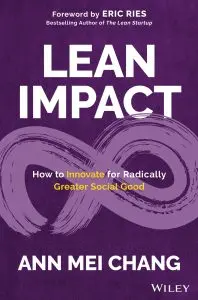Let’s be real. Innovation for social good is harder than innovation for business. Period. It took me some time to realize this. Like many practitioners of Lean Startup, the techniques seemed so universal that it was hard for me to imagine a domain in which they wouldn’t apply. Then I tried. I shared the methodology from Eric Ries’s seminal book The Lean Startup with a nonprofit. At first, reactions were positive, even enthusiastic. Most people recognized the innate uncertainty of their work and welcomed ideas for being more nimble, managing risk, and accelerating progress toward their mission. But then, nothing changed.
When people returned to their desks, they found a grant proposal to write or previously funded activities to execute. I discovered that traditional grants require that a detailed design be laid out in a proposal–down to discrete activities, budgets, and staffing –and that implementation must faithfully adhere to that plan. I came to call this the enforced waterfall model, in reference to the outdated process for building shrink-wrapped software when the need to manufacture and distribute floppy disks or CDs meant infrequent, high-stakes releases. Each stage of designing, building, testing, and shipping was planned in advance and performed sequentially. The advent of the web and cloud-based computing freed software development from these strictures and unleashed a wave of innovation.

Those mission-driven organizations that are fortunate enough to have access to more flexible funding may still find difficulty in satisfying their two entirely different types of customers: beneficiaries and funders. Even individual donors and impact investors frequently focus on defined geographies or sectors, be that health, education, poverty, climate, or otherwise. What if you’re funded to reduce malaria, but you discover that what is most needed are primary healthcare clinics? What if you’re funded to reduce rural poverty through agriculture, but people prefer to migrate to the city? What if you’re funded to improve girls’ education, but you realize what would make the biggest difference is sanitary pads? In the private sector, satisfying your user will increase profits and delight investors.
But in the social sector, what people want, what will make the greatest impact, and what funders will pay for are not always the same. The barriers to innovation don’t end there. Our instincts may lead us astray when working with populations whose experiences are quite different from our own. We work at the treacherous intersection of failed markets and failed policies. Metrics tend to be geared toward compliance and accountability, rather than decision-making and learning. Measuring social impact is far more complicated than measuring e-commerce transactions. And, taking risks implies a potential for failure that could jeopardize funding streams or make things worse for vulnerable people who are already living on the edge.
If you’ve found it difficult to adopt concepts from The Lean Startup and other innovation tool kits, you’re not alone. But, despite the added complexities, many mission-oriented organizations have found it not only possible, but transformative. They are better serving their customers, accelerating their growth, and magnifying their impact.

Principles of Lean Impact
Lean Impact is an approach to maximizing social benefit in the face of the complex challenges in our society. It builds upon the best practices for innovation from The Lean Startup and beyond, while introducing new techniques tailored to the unique nature of the mission-driven arena. By combining scientific rigor with entrepreneurial agility, we can dramatically increase both the depth and breadth of our impact.
The essence of Lean Impact is captured by three core guiding principles.
• Think big. Be audacious in the difference you aspire to make, basing your goals on the size of the real need in the world rather than what seems incrementally achievable.
• Start small. Between a desire to help people who are suffering today and pressure from funders to hit delivery targets, interventions often scale too soon. Starting small and staying small makes it far easier to learn and adapt–setting you on a path to greater impact over time.
• Relentlessly seek impact. Whether due to excitement, attachment, or the requirements imposed by a funder, we can become wedded to our intervention, technology, or institution. To make the biggest impact, fall in love with the problem, not your solution.
Despite the obstacles to innovation, nonprofits, social enterprises, companies, foundations, philanthropists, governments, and impact investors are beginning to chart a new path that embraces many of the concepts from The Lean Startup to solve the pressing social and environmental issues of our time. They are starting small, listening to their customers, rapidly iterating on solutions, and designing business models that can scale sustainably.
Recognize your brand’s excellence by applying to this year’s Brands That Matter Awards before the early-rate deadline, May 3.
